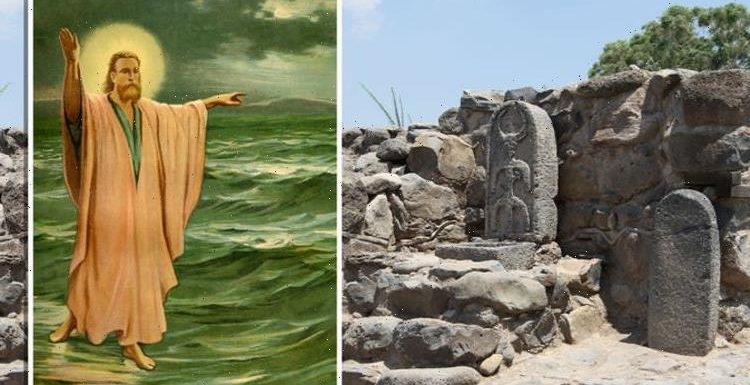
The Sea of Galilee: Expert discusses 1986 boat discovery
We use your sign-up to provide content in ways you’ve consented to and to improve our understanding of you. This may include adverts from us and 3rd parties based on our understanding. You can unsubscribe at any time. More info
The Bible describes Bethsaida as the hometown of the apostles Peter, Andrew and Philip, though little is said about its exact location. Bethsaida does, however, play a crucial role in the New Testament as it is the site of many of Jesus’s miracles. The Gospel of Mark, for instance, speaks of Jesus healing a blind man from Bethsaida with a touch of his hands.
Mark 8 reads: “He took hold of the blind man by the hand, and brought him out of the village.
“When he had spit on his eyes, and laid his hands on him, he asked him if he saw anything.
“He looked up, and said, ‘I see men; for I see them like trees walking.”
Another major miracle is said to have ocurred just outside of Bethsaida when Jesus fed some 5,000 people in the wilderness after multiplying two loaves of bread and two fish.
Shortly after this miracle, the gospels speak of Jesus’s disciples rowing out into the Sea of Galilee only to be caught in a fierce wind.


Matthew 14 reads: “Later that night, he was there alone, and the boat was already a considerable distance from land, buffeted by the waves because the wind was against it.
“Shortly before dawn Jesus went out to them, walking on the lake.
“When the disciples saw him walking on the lake, they were terrified.”
Whether or not these miracles truly happened, archaeologists have been desperately trying to discover the remains of Bethsaida.
Unfortunately, all efforts so far have been unfruitful and a source of intense debate.
The Roman author and naturalist, Pliny the Elder placed Bethsaida on the eastern shores of the Sea of Galilee in modern-day northern Israel.
Israel Antiquities Authority discovers Byzantine-era wine press
The Jewish-Roman historian Josephus, however, placed the town nearer to the Jordan river, which runs north to south between the Sea of Galilee and the Dead Sea.
Other historical sources place the town near the Roman fishing village of Capernaum, which itself sits on the northern shores of the freshwater lake.
Today, archaeologists point to two separate locations as the most likely location of Bethsaida – the archaeological sites of et-Tell and el-Araj.
The two sites, though only 1.2 miles apart, have emerged as the leading candidates for Bethsaida but, according to a report in Live Science, there is absolutely no agreement over which site takes the crown.
One team of researchers from the University of Nebraska Omaha believes et-Tell is the biblical site and has been excavating the ruins of the more than 3,000-year-old settlement since 1987.
But discoveries made at el-Araj have cast a shadow of doubt on this site and according to Jodi Magness, a professor in the Department of Religious Studies at the University of North Carolina Chapel Hill, there is “relatively scant” evidence of a thriving settlement at et-Tell around the time of Jesus’s ministry.


The settlement of el-Araj has been dated to at least the first century AD and contains a wealth of fascinating discoveries.
But some researchers have argued the site was likely submerged underwater around the time of Jesus’s life, based on geographical clues.
Of course, this has been disputed by other experts who seem confident the case for el-Araj is “overwhelming”.
Robert Cargill, an archaeologist and professor of Judaism and Christianity at the University of Iowa, told Live Science: “The case for el-Araj isn’t just convincing; it’s overwhelming and becoming more compelling with each excavation season.”
Some archaeologists have proposed a third, radical theory about the location of Bethsaida – both et-Tell and el-Araj were part of the same city.
David Graves, an archaeologist at the University of Glasgow, believes the main part of the city was found at the modern-day site of et-Tell, whereas the city’s harbour was located at el-Araj.
However, many experts do not believe this to be a satisfactory explanation.
Rami Arav, a professor of religious studies at the University of Nebraska Omaha, thinks it unlikely to be the case but conceded the people of et-Tell may have migrated to el-Araj after the city was ravaged by an earthquake in the fourth century AD.
Mordechai Aviam, director of the Institute for Galilean Archaeology at Kinneret College on the Sea of Galilee, agreed but said historical records indicate Bethsaida was upgraded to city status in the first century AD, whereas el-Araj was likely a bigger settlement at this stage than et-Tell.
Another, fourth, possibility is that Bethsaida was located at the archaeological site of el-Mesydiah, though theory appears to be less popular among experts.
Source: Read Full Article